![]()
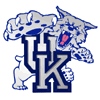 | - Part One - | 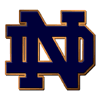 |
![]()
[Link to All-Time Series Results]
Overview
The series between Kentucky and Notre Dame (Kentucky currently leads 43-19) is one which has been off-and-on for over 80 years, and in that time frame has experienced some tremendous streaks, great performances by great players and some intriguing matchups. The personalities and relationships between players and coaches of these two schools has been more than enough to keep this series interesting, and promises to continue to do so in the future.
![]()
Game by Game Review
The first game between these two schools occurred in 1929, when then-Kentucky coach John Mauer took his squad to South Bend to play George Keogan's Notre Dame squad in venerable Notre Dame fieldhouse. From the late teens up to that time, Kentucky had begun to play a more regional schedule as the game grew. Kentucky had ventured into Indiana before, but had not fared very well against schools which were much further advanced in the sport.
During the early half of the century, basketball power in America was rooted on the East Coast (where the game was invented) and the Midwest (where the game was developed). Some of the pioneering development of the game of basketball can be traced back to Midwestern programs, such as Walter "Doc" Meanwell's 'scientific basketball' at Wisconsin, Harold "Doc" Carlson's 'figure eight' offense at Pittsburgh, Craig Ruby's 'submarine' offense at Illinois, Keogan's 'Western' offense and 'switching man-to-man' defense and the fast-breaking styles of Ward "Piggie" Lambert's Purdue Boilermakers and much later Branch McCracken's Hurryin' Hoosiers of Indiana. Basketball in the South was considered to be far weaker version than the game played in the North, with the Southern version featuring a plodding style and the sport itself often being associated with substandard facilities, under-qualified and uninterested coaching staff and an unenthusiastic fan base which was far more interested in the preparations for spring football.
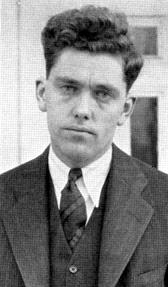 | John Mauer |
In 1928, Mauer was the latest Illini graduate to lead UK, having graduated in 1925 after captaining the team in basketball and working in the same backfield as the legendary 'Red' Grange in football. Mauer was a disciple of Craig Ruby and he brought along with him the 'submarine' attack which was novel to basketball in the South. This system utilized the bounce pass extensively along with a 'slow break'. Typically, four players would take up positions on the offensive basket while the fifth, the 'back-guard' would trail and defend the home basket (although from time to time he would enter the offensive fray near the center court and pop a long shot). Mauer was largely successful at Kentucky, as he developed the fundamentals of his players and with his 'submarine' attack largely baffling the Southern opposition.
The Wildcats nearly didn't make it to South Bend. Originally the team was scheduled to take a sleeper train to Fort Wayne (IN) where they were to transfer to the Pennsylvania Railroad which would take them to Plymouth (IN) and then South Bend. But at Fort Wayne the team was put on the Wabash Railroad bound for Detroit Michigan. They didn't realize the mistake until they were coming into Detroit. The Wabash scheduled a special train to get the team to South Bend. Instead of arriving at 7 AM the team didn't arrive in South Bend until 4 p.m. on Saturday, in time for the 8:00 PM tip-off.
When they finally got to play, the game was a low-scoring defensive affair with Kentucky coming out on top 19-16. Notre Dame got off to a slow start, scoring only two free throws in the first 10 minutes of the game against a tough UK defense. Kentucky led 12 to 6 at the half, but it was then that the Irish made their comeback bid. However, Kentucky center Stanley Milward scored a game high 9 points to lead UK and this was enough to secure the win. The 'Ramblers' (as they were called at the time) of Notre Dame were led by John McCarthy with six points. Kentucky's Paul McBrayer (who later would coach Eastern Kentucky) remembered the game fondly, describing it as "perhaps our best victory". He added "Notre Dame had a fine team and in George Keogan probably the best coach in the country, although he was overshadowed by football coach Knute Rockne."
[Boxscore] - 1928-29
While Keogan was building a juggernaut at Notre Dame, putting together teams which were later awarded two Helms National Trophies (in 1927 and 1936) to signify they were considered to be the best team in the country, Kentucky was undergoing major changes which would affect the fortunes of the program thereafter. After Mauer left Kentucky over a contract dispute in 1930, the university hired a Kansas graduate, Adolph Rupp, who had been coaching high school basketball in Freeport Illinois. Incidentally, it was Craig Ruby who tipped Rupp about the Kentucky job, mentioning that the position was vacant when Ruby was a guest speaker at Rupp's high school banquet. Rupp hesitated briefly but interviewed and beat a large field of applicants for the position. He quickly turned Kentucky into a power, feared in the South. He had also begun to gain national attention, with Kentucky being awarded a Helms Trophy for their 1933 squad.
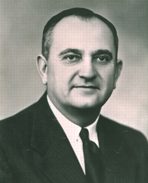 | Adolph Rupp |
In high school at Arsenal Tech in Indianapolis, Edwards' talent was not unknown to the local college coaches. In fact, his exploits were well known throughout the state of Indiana, however the coaches didn't believe he would ever be disciplined enough to attend college and therefore didn't waste much time recruiting him. It was Keogan who mentioned Edwards to Rupp "He's as big and tough as they come," Keogan told Rupp. "If you can just get him in school ...."
While Rupp was on his way to New York City, he received some friendly advice by way of telegram from his colleague Keogan from South Bend. Notre Dame had recently themselves played and lost in the Big Apple and Keogan strongly suggested to Rupp to take his own referee, Frank Lane, to the contest, "or you don't have a chance." Rupp failed to take Keogan's advice and Kentucky paid for that oversight dearly, losing by one on a last-minute foul shot.
Part of the Wildcat attack involved setting screens to allow players to get open for shots. This type of offensive maneuver was novel to teams on the east coast and the eastern official's reaction to this tactic was to consider it a foul, which severely hampered Kentucky's offensive sets. On the other hand, grabbing, holding etc. of a player by the defense was apparently considered fair game to the officials and the Violet big men draped themselves over Edwards at every possession. The play was rough, and Edwards was limited to only 6 points, ten below his average. Despite this, the New York fans and press were suitably impressed with Edwards. Even the hometown press admitted that Kentucky would have won the game with a more balanced officiating crew.
Edwards went on to gain All-American honors that year and despite only playing that one season before dropping out of school to play in a semi-professional league in Indiana, was named to many all-decade teams from the 1930s. The game between Kentucky and NYU also left a legacy on the game of basketball, as it was the rough play in that contest which helped lead to the adoption of the 3-second rule which prevented offensive post players from staying inside the paint for more than 3 seconds at a time. This rule was passed in the hope of cutting down on rough play under the basket.
Although Keogan and Rupp had each developed powerhouse programs, it was not until 1936 when the series between the two schools was resumed. This may be explained because although transportation had improved to make longer distance trips more feasible, it was still not routine to travel distances from places like Lexington KY to South Bend. The depression no doubt also put a crimp into expensive road trips.
The first game between Rupp and Keogan was held in Notre Dame's Fieldhouse. Interestingly, it was Leroy Edwards who had urged Rupp to schedule the trip (to Notre Dame and Butler) as kind of a homecoming in Edwards' home state. However with Edwards long gone along with Dave Lawrence who graduated the year previous, Rupp was left with a green squad and a daunting schedule with away games against the likes of NYU and a Notre Dame squad which would later be named awarded Helms National Titles. To make matters worse, Rupp had suspended Joe 'Red' Hagan for the game due to an incident over awarding of the game ball from the previous game (not the first time this would happen BTW). Initially Hagan was not supposed to even make the trip to Indiana but he showed up at the train station and Rupp decided to let him come along at the last moment.
The game itself was a blowout, with Paul Nowak (11 points) and Johnny Moir (17 points) leading the way for the Ramblers. These two players would earn All-American accolades over the next three years and along the way terrorize their Wildcat opposition. Notre Dame also received stellar defensive work from Frank Wade. Part-way through the game, with Kentucky down by 14 points, Rupp lifted Hagan's suspension on the spot, reportedly waving a scrap of paper and saying "I just got a telegram. Your suspension has been lifted and you can go in now." Hagan was able to contribute six field goals, but it wasn't nearly enough to change the outcome. The score actually could have been worse, however Keogan instructed his reserves to pass the ball around instead of shoot and the final margin was only 21 points. Kentucky was able to salvage the trip somewhat when they beat a Tony Hinkle-led Butler Bulldog team the following night in venerable Butler Fieldhouse.
[Boxscore] - 1935-36
The following year, Kentucky and Notre Dame met in Louisville, Kentucky in what was the first of many meetings in the River City. The game was held in the Jefferson County Armory. Kentucky contributed bleacher stands to the Armory for the contest. With all seats made available for $1 tickets, 6,352 people attended the game. This crowd was the largest to see a basketball game in the state of Kentucky up until that time, and far larger than UK's Alumni Gymnasium (the gym that UK played their home games) could accomodate. Despite concern over the state of the playing surface, $5,700 was collected as gate receipts and the experiment was considered a success.
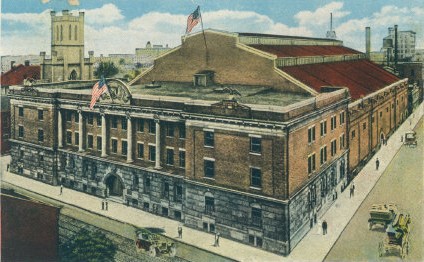 |
| Jefferson County Armory - Louisville, KY |
Kentucky scored the first point but that lead quickly evaporated and the Wildcats found themselves on the short end of a 28-9 tally at the half. Moir and Nowak again led the way for Notre Dame. This despite the forward Moir playing with a rubber helmet due to having a fractured jaw and the center Nowak recovering from appendicitis. Rupp said about the game:
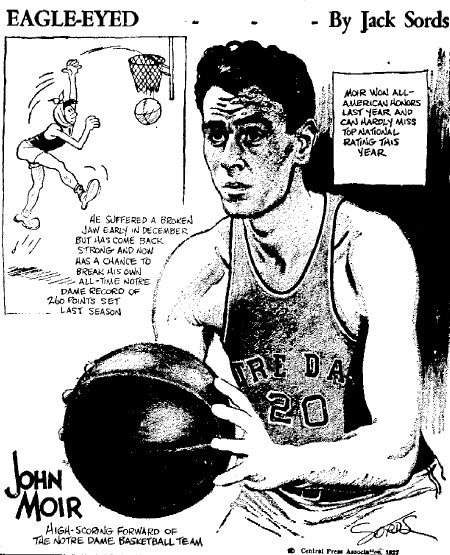 |
| John Moir: All-American |
Rupp was able to rally his squad and UK was able to cut the lead to 10 in the second half, however it was at this point that the Irish went into a stall and salted the game away using their ball-handlers. One of these ball-handlers was a player from Chicago, Raymond Meyer. Meyer would be heard from again for years to come as an opposing coach at DePaul University, a position which provided him plenty of opportunities to compete against both Kentucky and Notre Dame.
After the contest, players from both teams were invited to the Brown Hotel for a reception in the Crystal Ball Room held by alumni of both schools.
[Boxscore] - 1936-37
 |
| Action from the game in Louisville. Top: Notre Dame's Johnny Moir (#20 in a rubber helmet) slips by Homer "Tub" Thompson (#13) and Warfield Donohue (#6) for a shot. Bottom: Notre Dame's Ray Meyer (#18) shoots over Homer "Tub" Thompson (#13) |
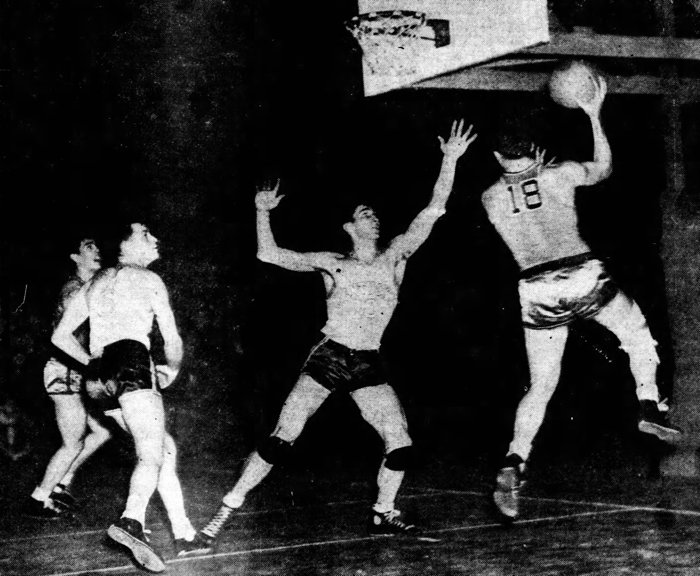 |
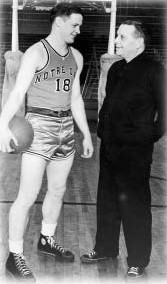 |
| Eddie Riska and George Keogan |
The following season, Moir and Nowak were gone, however a new crop of Notre Dame stars took their place and the results were the same. A new record of 7,000 people showed up in the Armory in Louisville to see Eddie Riska and Eddie Sadowski lead a balanced Irish attack. Notre Dame hit 22 of 24 free throws to ensure a 5-point victory.
The 1940 game again returned to South Bend and the Irish again came out on top, leading 28 to 21 at halftime. Riska led all scorers with 17 points and George Sobek added 10. Layton Rouse led Kentucky with 13 points. The difference in the game proved to be field goal shooting, with the Irish shooting a very good (for the time) 38 percent to UK's 29 percent.
[Boxscore] - 1937-38
[Boxscore] - 1938-39
[Boxscore] - 1939-40
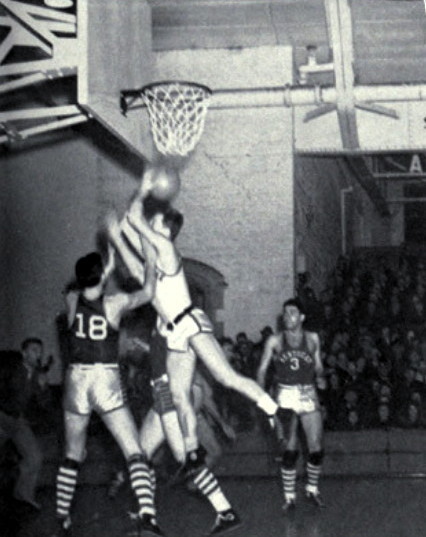 | 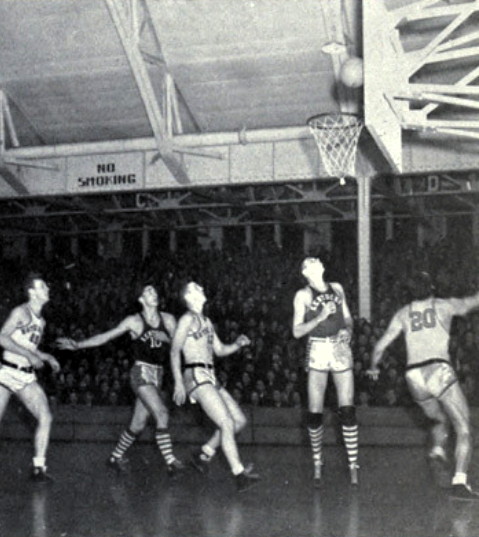 |
The game in Louisville the following year, it looked to the 4,600 spectators like Notre Dame would run away with the game once again. The Kentucky team was returning from a long road trip to Louisiana where they had played in the Sugar Bowl tournament, but along the way picked up a bug. By the time they arrived in Lexington, their star Lee Huber had caught the flu and was hospitalized for a number of days prior to the contest, only being released from the hospital the day of the game. Other players had also fallen ill including Milt Ticco who was also recovering at the hospital and Jim King and Keith Farnsley who were recovering in their own beds.
Given the poor state of the UK squad's health, there was little hope of an upset, but the Wildcats came close. Leading 28-19 at halftime, the Irish extended the lead to 36-19 before the Wildcats would respond. Kentucky went on a 15-3 run at that point and were able to hold Notre Dame to only two field goals for the remainder of the game. Kentucky was behind by five points with a minute and half left when Waller "Whizzer" White rebounded a free throw miss by Lloyd Ramsey and made the put back. Late in the game, Huber scored on a put-back and Kentucky celebrated a great comeback to knot the score at 48-all, or so they thought.
A 10-minute discussion broke out at the scorers table to iron out a discrepancy between the scoreboard operator and the official scorers. It turned out that a Kentucky player had stepped over the free-throw line when attempting to shoot a foul. The referee had nullified the score but the scoreboard operator did not pick this up, a situation played out over twenty years earlier when a similar error resulted in a tie-game between Kentucky and Kentucky Wesleyan. Instead of an overtime period, the game was officially called in Notre Dame's favor 48-47.
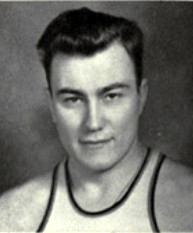 |
| Raymond Meyer as a player at ND |
[Boxscore] - 1940-41
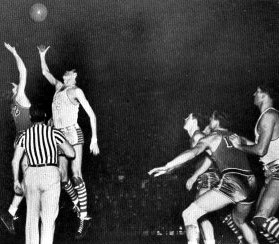 |
| Mel Brewer tips off against Notre Dame in the Armory |
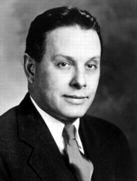 |
| George Keogan |
Kentucky did put on a good showing in South Bend the following year, leading most of the game and enjoying a 22-15 lead at halftime. But Notre Dame mounted their comeback, which was aided by the banishment of Kentucky's Kenny England and Captain Carl Staker on fouls, and when Johnny Niemiera stole the ball and scored, the game was tied at 36-all. After baskets were traded once more, Notre Dame went ahead and never looked back. Bob Rensberger led the Irish with 17 points, while Mel Brewer and Carl Staker scored 7 each to lead Kentucky.
[Boxscore] - 1941-42
Adolph Rupp was now 0-7 versus his colleague in South Bend, and if he expected to win the next game, it would promise to be a difficult task, as Keogan had assembled what he considered to be his best team to date. The Irish entered the game 6-0 and looked to be the clear favorite. As with most of the contests, Notre Dame sped out to an early lead and was on top at the half, 33-27. This margin was increased to 10 points early in the second half, but this time, Kentucky had an answer. Marvin Akers paced Kentucky with 17 points while Milt Ticco added 16. Together they helped chip away at the Irish lead and eventually put Kentucky on top. Eventually, Akers, Ticco and Ken Rollins would all foul out of the contest, leaving Melvin Brewer as the only veteran. But with a slim lead, Kentucky was able to hold the Irish to a standstill and the final score was 60-55.
Said Adolph Rupp years later when remembering the game, "Notre Dame called time out. Mel Brewer, Kentucky's center who was killed in the Normandy invasion gathered the subs around him and with his long arms reaching over their shoulders, patted each on the back as if to say, 'Here's the spot. Let's get he job done.' It was a picture I'll never forget."
After the game, Akers said, "It was a great night for Adolph Rupp. He's now thoroughly convinced that all things come to those who wait." The following week Notre Dame assistant coach Ed Krause was quoted: "We have lost only one game in seven...And that loss was to the University of Kentucky in Louisville last week. That Kentucky team is one of the very best we have seen in 10 or 20 years."
Years later, Rupp would talk about his first victory over Notre Dame, "That was our first big break," he said. "They beat us seven straight times before we got good enough to beat them. I learned something every time we played them."
In another interview, Rupp expressed similar sentiments. "So we went up there to Notre Dame, I think they beat us six (sic) times in a row before we finally beat 'em. And I kept going back and back, because if they were better than we were, I was going to find out what made them better. And I found out some of the answers by getting beat by those teams."
[Boxscore] - 1942-43
Rupp had finally secured a win over his good friend from South Bend who he once described as "a ball of fire," but less than a month later, that victory would not be so sweet as tragedy would strike.
On February 17, Notre Dame had bounced back nicely from their lone defeat in Louisville and was sitting with a record of 12-1. George Keogan sat down to read his evening paper and was struck with a massive heart attack which killed him at the age of 52. His death was a terrible blow to the Notre Dame community, much like Knute Rockne's death ten years before. Keogan's final collegiate record was 418-125, which included 7 years at various other schools before he took the Notre Dame position.
On February 20, the distraught team buried their coach in the morning and then, at the urging of Keogan's widow, went on to Chicago Stadium to play Great Lakes Naval Station. Incidentally, the match in Chicago was a double-header. The early game pitted Kentucky against DePaul and George Mikan in the first meeting ever between the two schools. The nightcap featured Notre Dame against the Naval squad. Mikan scored 18 points to pace the Blue Demons, but more importantly stationed himself beside the basket on the defensive end and swatted away any jump shot earmarked for the goal. This was prior to any goal-tending rules and given this handicap, the Wildcats (who's strong suit that year was their perimeter shooting) were hopelessly disadvantaged and lost 53-44. The Notre Dame squad lost in overtime to the sailors in the finale.
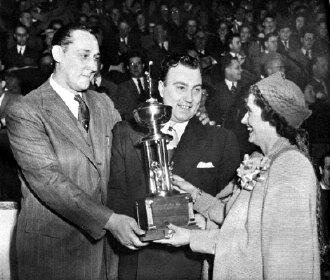 |
| George Keogan's widow accepts a memorial trophy in his honor from then-Notre Dame coach Ed Krause and DePaul coach Ray Meyer during the 1947-48 season |
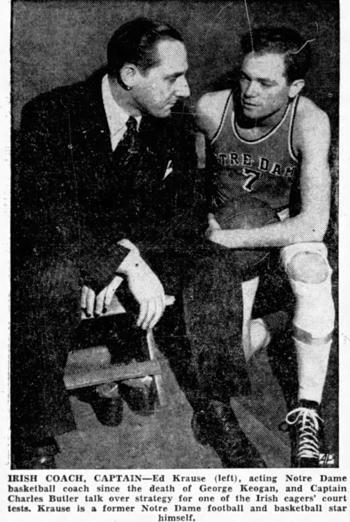 |
It was at DePaul where one of Meyer's first and greatest accomplishments was to help develop a young George Mikan into the most dominating big man ever seen up to that time. Mikan had actually tried out for Keogan, hoping to gain an invitation to enroll at Notre Dame, however at the time Mikan was extremely raw and was badly outplayed by Ray Kuka, who did make the Irish team. Keogan broke the bad news to Mikan that he just wasn't coordinated enough for basketball. Meyer, who was at the workout, apparently saw some potential and he was pleasantly surprised to find a freshman Mikan walking around the DePaul campus the spring that Meyer took the job. Meyer, who always recognized the advantage of having a big man, immediately set about to transform Mikan into a bona fide basketball player.
The following year proved to be another thriller between these two teams. Going into the contest, the Wildcats were favored, however Rupp would have none of it, suggesting the game would be a "toss-up". When questioned by reporters, he asked rhetorically "Did you ever see a Notre Dame team that was a pushover?" Rupp always did take his opponents seriously, especially a Notre Dame program which seemed to have his number. It's been reported that before the game, Kentucky had dressed at the Kentucky Hotel across the street from the Armory and were readying to make the short trip to the stadium by foot. UK player Don Whitehead had laughed at loud at something he found funny. Rupp turned and sternly scolded him "Don't you realize we're playing Notre Dame?"
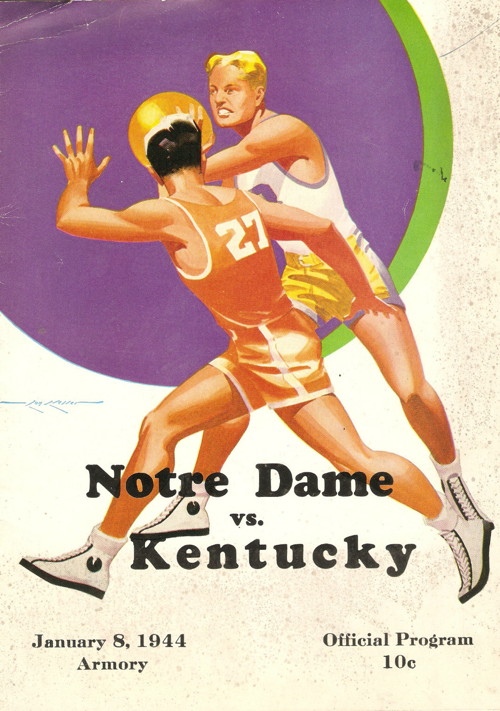 |
| Game Program |
"With a minute and a half to go Kentucky was trailing by 54-52. Then, in the backcourt a Notre Dame player passed laterally to Marko Todorovich. He shouldn't have made the pass because Brannum was too close to the silent Serb. But he made it -- and Brannum was on Todo like a wart on a pickle. He slapped the ball out of his eager fingers and dribbled in, with Todo in hot pursuit, for the game-tying crip and when Todo hacked him from behind as he shot, Brannum had the game in his lap."
"It was 54-54, a minute and a half to go, and the winning point his if he could make it. When fouled, Brannum lifted his arms in happy jubilance. This dismissed all uncertainty that he would make the free throw. He knew he would and he did."
The remaining minutes were wild as both teams scraped and clawed for the ball, however no more points were scored. Guard Walter Johnson led Kentucky with 15 points while Brannum added 14 (seven in the final three and half minutes) and Jack Tingle 12. Todorovich led Notre Dame with 15 points with Carl Lloyd adding 14 and Notre Dame's big gun, Leo Klier, adding 13.
[Boxscore] - 1943-44
The next year saw some major changes in the lineups, however the game once again came down to the wire, with Notre Dame winning in overtime. Brannum was gone into the service, only to be replaced by another freshman sensation at center, Alex Groza. Unfortunately for Kentucky, Groza too had been inducted into the armed services and was no longer on the team to match up with the Irish.
The war years were difficult times, with many programs disbanding due to lack of eligible players and players called off to war throughout the year. Rupp used freshman extensively along with 4Fs, but still struggled hard to keep his program going during this time. At one time he exclaimed to a newspaperman that he'd play "all girls" if he had to. Other programs benefitted in some ways as they were able to pick up college stars who were stationed at military training centers set up on selected campuses. The Irish were one of the programs who tended to fare better than most with the war raging overseas. They picked up a former All-American at Georgetown University Billy Hassett and former Loyola player Johnny Dee, although they lost the Naval trainee Leo Klier that year. 17-year old freshman Vince Boryla played center for the Irish and he was the leading scorer that year. The war not only affected the player ranks but the coaching ranks also. Notre Dame coach Edward Krause decided to join the war effort and convinced the Notre Dame football coach, Frank Leahy, to do likewise. Notre Dame decided to hire former Xavier coach (and Notre Dame alum) Clem Crowe to lead the Irish that season.
The game was one of runs. Kentucky played erratic the first half and slipped into a 35-23 deficit at halftime. This lead worsened in the first three minutes of the second half as the Irish pushed the lead to 45-31. However Jack Tingle and Kenton Campbell (the man who replaced Groza in the pivot) were able to bring the Wildcats back and Kentucky led 58-57 with a little over a minute to go in overtime on a Jack Parkinson shot. Johnny Dee, however, had an answer and his left-handed flip put Notre Dame on top for good at 59-58. The Irish were successful in freezing the ball for the remaining minute and claimed the victory.
Kentucky had a chance to win the game in regulation, when Tingle stole the ball with only seconds to play and streaked down the court for a game winning layup. However Notre Dame's Frank Gilhooley grabbed at Tingle's shirt tail, getting just enough cloth for a foul to be called and seconds before Tingle made the crip which would have put Kentucky on top 54-53. The goal was disallowed and an intentional foul was called on Gilhooley, giving Kentucky two shots. Tingle missed the first shot but was able to salvage the trip by hitting the second which tied the score. Said referee Hickman Duncan after the game: "When I called the foul on the circle the ball became dead. The goal couldn't count, but the foul was obviously intentional - a flagrant foul to keep Kentucky from scoring. I awarded Kentucky two free throws and the boy was able to sink only one." Bill Hassett launched a desperation shot from Kentucky's end of the court, which sailed over the backboard, and the game was sent into overtime.
[Boxscore] - 1944-45
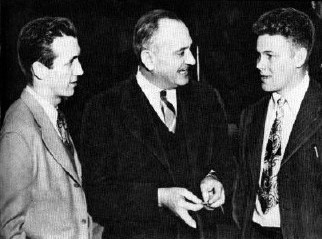 |
| Adolph Rupp shares a light moment with Notre Dame players Johnny Dee (left) and Billy Hassett (right) before a game in Louisville |
The next year at the Armory in Louisville, a new face was once again leading the Irish. The face was that of Elmer Ripley who had coached, among other places, at Georgetown, Yale and Columbia. Before the game was even played, there was some controversy as Kentucky's AD Bernie Shively, citing overwhelming ticket demand in Louisville, proposed that an additional game be played the night before the scheduled match. Notre Dame and Ripley declined the suggestion, saying that they intended to 'adhere to the original schedule.'
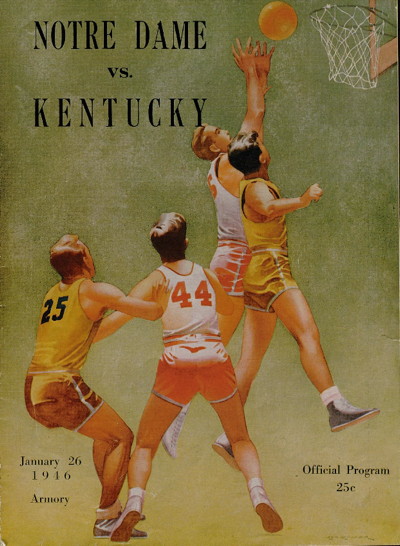 |
| 1946 Program |
Vince "Bullets" Boryla led the way for the Irish with 18 points, while his counterpart in the Kentucky pivot, Wallace Jones, paced the Wildcats with 16. Kentucky ace Ralph Beard was playing in his home town of Louisville as a collegian for the first time and was shut out of the scoring column, largely on the defensive efforts of Johnny Dee. Beard was so distraught over his performance that later he said "I felt like jumping off a bridge." Here's an excerpt from Russell Rice's Big Blue Machine:
Irish Coach Elmer Ripley, knowing Beard's remarkable speed and fondness for leaving his defensive assignment to seal an opponent's pass, set a trap for him. On the first Notre Dame offensive pattern, a guard faked a pass to All-American Billy Hassett, who was being guarded by Beard. When Beard left Hassett and jumped between the guard and Hassett to intercept what he thought was an obvious pass, Hassett reversed direction, took an easy "backdoor" pass, and had a clear path to the basket for a layup.
Realizing that he had been "suckered" before the home crowd, Beard tightened up and for the rest of the night was unable to recover his customary poise. Rupp told him he had to learn how to relax, to learn to lose his pregame tension and "to go out and break training, miss practice a few days, do something drastic." [Jack] Tingle and [Jack] Parkinson allegedly spotted Beard in a downtown cafe, solemnly following orders by stuffing himself with pie, ice cream, and Coca-Cola.
[Boxscore] - 1945-46
The following year, the game was again held in the Armory and with the war commitments lapsing, many familiar faces were returning to the collegiate campuses. For Kentucky, both Alex Groza and Bob Brannum returned to compete for the center slot on what was perhaps the deepest basketball team of all-time.
For Notre Dame the former coach, Edward Krause had returned but beyond that, things didn't look so rosy. Vince Boryla was gone, having enlisted in the army. Added to that was the fact that Leo Klier, Billy Hassett, Johnny Dee and Frank Gilhooley had all graduated. From the 1946 team, only George Ratterman returned of those with much experience. He was joined by some young talent in sophomore Leo Barnhorst and freshman Kevin O'Shea, but this Notre Dame team was severely overmatched and Kentucky ran away with a 60-30 victory. Alex Groza led all scorers with 18 points while Ralph Beard was not far behind, contributing 17 of his own.
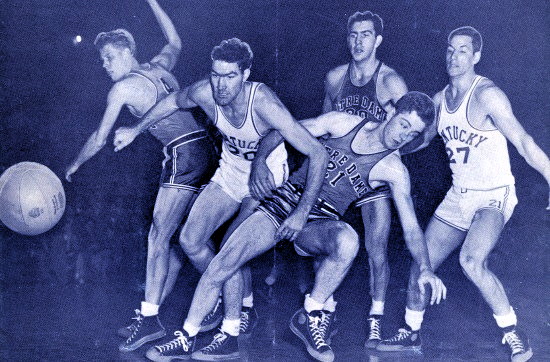 |
| Bob Brannum bowls over two Notre Dame defenders while tracking down the ball. |
[Boxscore] - 1946-47
In the aftermath of World War II, Kentucky was riding high between the young players who had been developed and the experienced players who were returning from the war. Coach Rupp literally had All-Americans sitting the bench. Notre Dame, on the other hand, didn't seem to fare as well, potentially due to the coaching instability of the time and after years of the infusion of naval trainees contributing to Notre Dame's talent level, the after-effects of Keogan's passing finally catching up with the Irish.
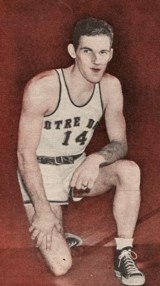 |
| Notre Dame's Kevin O'Shea |
Remembered UK guard Ken Rollins about the Notre Dame crowd, "The only place worse than that [Tennessee's Hecklers Row] was the Notre Dame Field House at South Bend. They'd pinch you, shove you, and pull the hair out of your legs when you took the ball out of bounds. Their band was right in your ear."
The battle was tight through most of the game, with Notre Dame holding on to a 2-point lead at halftime. The Wildcats were uncharacteristically off-form in the shooting department, hitting only 23 percent compared to their Irish opponents who shot 32 percent. The scoreboard showed 50-48 Notre Dame late in the game before the Irish went on a run and UK's poor shooting finally caught up to them. The Irish twice ran out to leads of 10 points which the Wildcats tried to cut but eventually could not overcome. Kevin O'Shea salted the game away by hitting his free throws down the stretch.
O'Shea led the Irish with 23 points while Leo Barnhorst added 16 and John Foley 14. Kentucky was paced by 23 points by Alex Groza and 17 by Ralph Beard. This game would be the first of many well-known post-war upsets at home by the Irish.
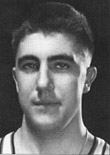 |
| Vince Boryla |
[Boxscore] - 1947-48
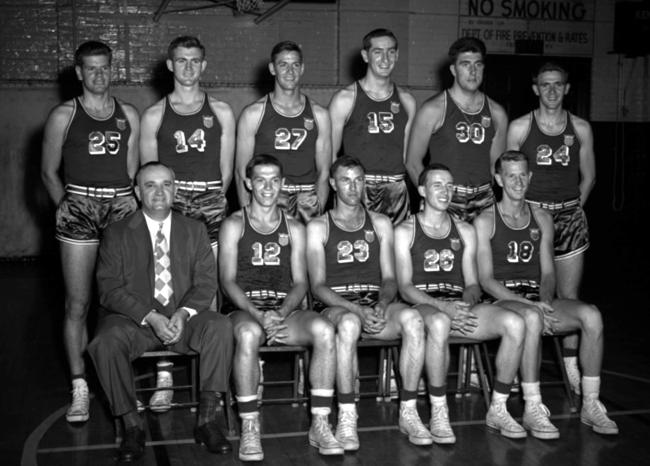 |
| The University of Kentucky Wildcats plus two outsiders prepare for the N.C.A.A. Olympic Fund three-game series with the Phillips 66'ers in the summer of 1948 From left to right (Front row): Head Coach Adolph Rupp, Ralph Beard, Cliff Barker, Kenneth Rollins and Dale Barnstable (Standing): Jim Line, Joe Holland, Wallace 'Wah Wah' Jones, Alex Groza, Vince Boryla (Notre Dame) and Ray Lumpp (NYU). |
The return trip to the Armory in Louisville proved to be payback against the South Benders. Rupp had his team ready. According to Alex Groza, "[Rupp] had scouted them 3 times. He was telling us how tough this club was. He had us so high nobody in the world was going to beat us."
Kentucky dominated the game, allowing only 20 field goal attempts by the Irish in the first half en route to a 33-16 halftime lead. Kentucky went on to win the game 62-38. Alex Groza was the offensive star as his deft moves around the basket and clever offensive attack left his Irish defenders helpless. Groza scored 22 points but perhaps even more important to the Wildcat cause were the defensive jobs of Ralph Beard and Wallace Jones. Beard clamped down on the All-American O'Shea, who was limited to only 5 points.
[Boxscore] - 1948-49
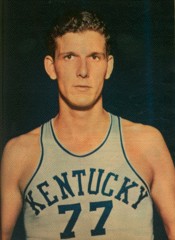 |
| Bill Spivey |
As with the game in 1948, the power of the Notre Dame Fieldhouse once again was too much for Adolph Rupp and Kentucky to overcome as they went down to defeat 64-51. A raucous capacity crowd of 4,000 watched as the Irish sped out to a 10-point halftime lead, 39-29. The Irish did a good job of preventing Kentucky from getting the ball inside, where they had stationed 7-footer Bill Spivey. Forced to take long outside shots, the Wildcats once again lost their shooting touch in the Fieldhouse. Spivey was able to score 27 points, mostly on tip-ins of missed shots, but he received little help from his teammates and it wasn't nearly enough to overtake Notre Dame that night. Spivey's points were more than half of Kentucky's total output. Kevin O'Shea led a balanced Irish effort with 18 points.
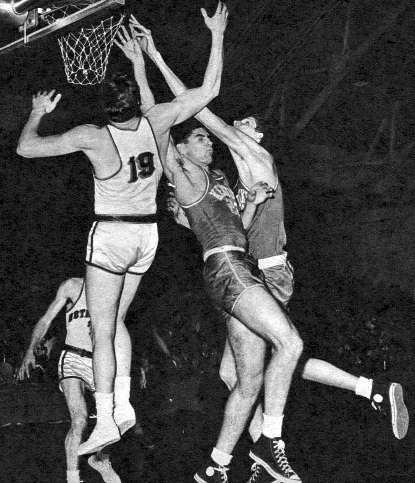 |
| Bill Spivey and Notre Dame's Dan Bagley (19) fight for the ball while Walter Hirsch gets caught going the other way. |
That game proved to be the last one Kentucky ever played in the old Fieldhouse, which had been in service since the turn of the century. Rupp, having seen some of his greatest squads go down to defeat and superstitious to a fault, finally resigned himself to never being able to grab a victory in the gymnasium. According to Krause:
"Rupp said there was no way you can win at Notre Dame. He said the band was right behind him and he couldn't hear the whistle blow, and he couldn't even talk to his players. Right across the way, he said, were 300 black robes -- the priests. He said it was impossible."
The fact that this was the final game in the Fieldhouse wasn't the only thing to change in the series between the two schools. In some ways, this game marked the turning point. Notre Dame enjoyed an 11-5 record in the series at the time, but from that point on, Kentucky would turn that figure on its head.
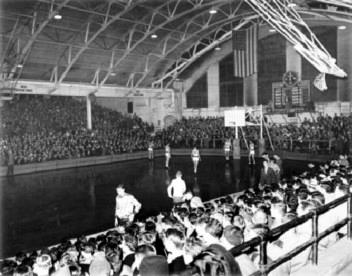 |
| The Notre Dame Fieldhouse |
[Boxscore] - 1949-50
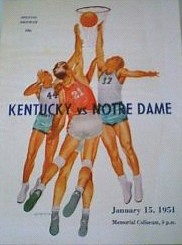 |
| 1951 Program |
The Wildcats were ranked #3 in the country, and looked to be on top of the world. Their best player was seven-foot junior Bill Spivey who averaged over 19 points and 17 rebounds per game and was poised to make a national splash. There was plenty of talent on the team to back him up, including Shelby Linville, Bobby Watson and two young future Hall-of-Famers in Cliff Hagan and Frank Ramsey.
 |
| Lou Tsioropoulos fights for the ball |
The following game between the Wildcats and the Irish was held in Chicago Stadium and proved to be a much tighter contest. In a thrilling game, the Wildcats came back from a half-time deficit to rally ahead and hold on in the final ten minutes, despite losing the services of Cliff Hagan, Lou Tsioropoulos and Frank Ramsey to fouls. In the final few minutes, with Kentucky clinging to a four point lead, the Wildcats successfully went into a freeze, largely due to Gayle Rose's dribbling abilities. Richard Rosenthal led the Irish with 25 points.
[Boxscore] - 1950-51
[Boxscore] - 1951-52
The series lay dormant until the two squads were matched together in the 1958 NCAA Tournament. The teams were playing for the right to participate in what later would be coined the 'Final Four.' Unfortunately for Notre Dame, the game was played in Kentucky's Memorial Coliseum. This was at a time when schools really did compete in their own 'region' during the early rounds of the tournament and there was no rule against a team playing on its home court during the NCAA Tournament.
Rupp was once again leery of Notre Dame. Kentucky center Ed Beck, who was also a Methodist minister, wrote about a situation prior to the game.
Being the motivational expert that he [Rupp] was he would always use everything that he could to gain the upper hand on his opponent. One time as we played Notre Dame he came in before the game, and he said, "Boys, I don't want you to get upset or feel that you are outnumbered when you see the Notre Dame boys cross themselves before the game or before every free throw. Now don't worry about all those priests that they have on the bench because we have them outnumbered." He said, "We have Ed, and I know he has been praying," and then with that certain grin he pulled out of his pocket a small madonna and said, "The last time I was in Rome the Pope blessed this, and I have put the hex on Notre Dame."
Although on paper the teams were evenly matched (Notre Dame ranked #8 and Kentucky #9 in the AP poll), Notre Dame coach John Jordan was confident that his 23-4 Irish could advance past the 20-6 Wildcats. Instead, Kentucky won convincingly and handed the Irish their worst defeat ever, 89-56. Kentucky relied on the scoring of Vernon Hatton who contributed 26 points to the Wildcats cause. John McCarthy led Notre Dame with 17 points, followed closely by the Irish All-American Tom Hawkins with 15 points. Kentucky went on to advance to the Final Four in Louisville's Freedom Hall where they beat Temple by one point, and then got by Elgin Baylor and the rest of his Seattle teammates for the national title.
[Boxscore] - 1958 NCAA Tournament
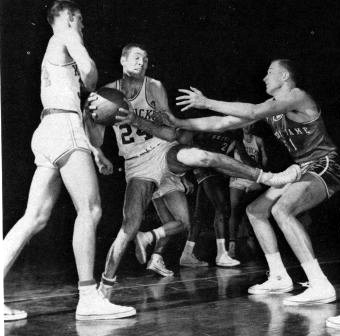 |
| Johnny Cox (24) gives Notre Dame's Tom Reinhart (51) the boot while Ed Beck looks on |
The NCAA game must have awakened someone to the forgotten series between the two schools as the very next year, the two met up again in the regular season. In staying true to Rupp's pledge to not return to South Bend, the first game of the renewed series was held in Chicago Stadium and Kentucky won convincingly, 71-52. The return trip to Lexington the following year proved to be tighter, but again Kentucky prevailed, this time 68-65 in front of 6,800 hardy souls who braved a blizzard outside (most walked to the game) to see the action. Kentucky shot 64 percent in the first half to post a 44-30 lead, only to see their shooting turn as cold as the weather outside. The Irish mounted their comeback on the shoulders of former Louisville St. Xavier star Eddie Schnurr, who was making his first career start. Schnurr scored 15 points and shared high scoring honors with John Tully. Don Mills paced the Wildcats with 19 points.
[Boxscore] - 1958-59
[Boxscore] - 1959-60
December of 1960 saw the series return to the city of Louisville, this time in Freedom Hall. Kentucky entered the game with a middling 1-1 record, having a poor showing against VMI in the season opener and then losing to Florida State at home. Undefeated Notre Dame sped out to a 16-7 lead but Kentucky's Bill Lickert helped bring the Wildcats back, finally knotting the score at 36-all shortly after the intermission. Kentucky's dominance of the boards proved to be the difference, as they held a 50-39 edge. Lickert finished with 21 points while Roger Newman and Vincent Del Negro added 13 apiece. The Irish were led by John Tully with 18 points. After the game, Coach Rupp said "The boys got the spark and wanted to win .. The criticism was biting in Lexington already."
[Boxscore] - 1960-61
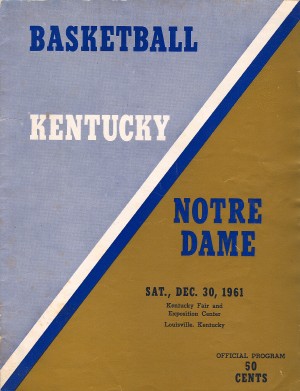 |
| 1961 Program |
The next three years turned out to be the Charles "Cotton" Nash show, as the Wildcat marksman scored 31, 26 and 33 points respectively to lead Kentucky, which scored 100 or more points twice in the three games. The best shot the Irish had was in 1962 when sophomore Larry Sheffield scored 28 points to keep the Irish within striking distance. However, Nash went 12 for 12 from the free throw line and UK's overall free throw shooting prowess proved to be the difference, and the Wildcats won by 8 points.
After a 101-81 drubbing by the Wildcats in Nash's senior year which occurred despite 27 points from Sheffield and 25 points from Ron Reed, Notre Dame coach John Jordan said about the #2 ranked Wildcats "I saw reactions out there I've never seen any place." He added, "I've seen teams with one or two quick-reacting men, but never one with five or six.... That's the best team -- and I emphasize team -- I've seen in years. That's a real team."
[Boxscore] - 1961-62
[Boxscore] - 1962-63
[Boxscore] - 1963-64
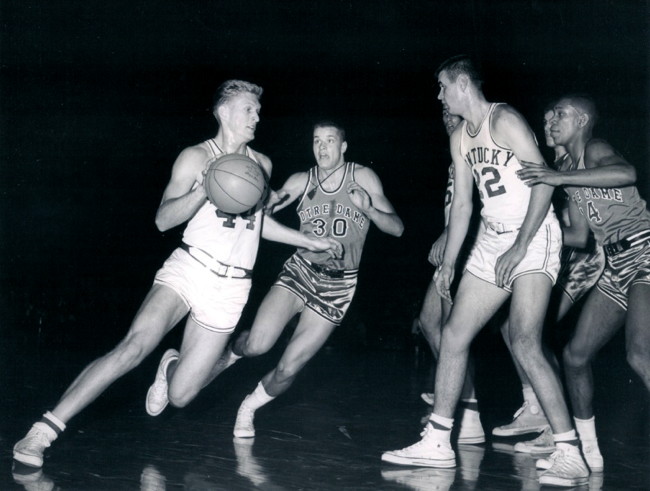 |
| Cotton Nash drives on Notre Dame's Jay Miller (30) |
After losing nine straight games and seeing their once-imposing series lead not only shrink but become overtaken, the Notre Dame program saw a new coach at the helm for the Irish, but one who was not unfamiliar to Wildcat fans. Johnny Dee not only had played for Notre Dame during the war years, but had (before he took the job at Notre Dame) gone on to be named the youngest head coach in the nation at the time when he signed on with Kentucky's Southeastern Conference rival, the University of Alabama in 1953.
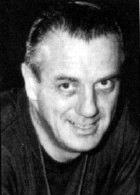 |
| Johnny Dee |
The following year, Kentucky and Alabama met at Memorial Coliseum with the winner clinching at least a tie for the SEC Championship. Before the game during warm-ups, an Alabama substitute (Jim Bogan) dared Dan Chandler to cross the center court line onto the Alabama side. When Chandler crossed the line, a melee resulted which involved fisticuffs between a number of players. It took a number of peacemakers and police officers to restore order. Kentucky won the game convincingly 66-52.
The bad blood lasted between the teams and the coaches. During warmups, the substitutes of both teams would line the half-court stripe staring at each other. Rupp and Kentucky won the next game against Dee also, although the third and final year Dee was with Alabama, the Crimson Tide squad (dubbed the Rocket 8) did hang a defeat on Kentucky 101-77 in a game played in Montgomery's Garrett Coliseum. Despite enjoying a large lead, Dee left his starters in the game and ended up only briefly playing two reserves during the entire contest. Late in the game, Alabama's George Linn stole the ball at half-court and went in for a lay-up which put Alabama over the century mark, the highest point total ever scored against Kentucky up to that time. Said Rupp after the game, "Boys, back when I was playing, we would have taken that ball and eaten it, chewed it up, and swallowed it before we would ever let them score 100 points on us."
Alabama went on to win it's first conference title in 22 years that season, however Kentucky and Rupp had the last laugh. Kentucky was voted by the league to represent the SEC in the NCAA Tournament because the entire Alabama starting five were ineligible for NCAA action due to having four years of varsity experience (they had participated on the varsity team while freshmen in 1953 after relocating en masse with Dee, who before taking the Tide position was an assistant at Notre Dame. At the time, the SEC still allowed freshmen to participate on the varsity, although most of the rest of the NCAA schools had returned to their pre-war status of freshmen ineligibility.)
Later when discussing Kentucky's dominance over the Southeastern Conference, Dee reportedly said: "Adolph Rupp has won 800 and some games. Five hundred of them have been against Southeastern Conference teams. That's like me going down to Texas with six kids from Canada and starting a hockey league."
Dee left the Alabama program after that season to coach an amateur team sponsored by a trucking company, but would resurface nearly ten years later with Notre Dame. Dee's first rematch against Rupp and Kentucky again proved successful and the Irish gained some measure of revenge for the previous year when they rushed past the Wildcats 111-97. This proved to be the highest point total any opponent had scored against Kentucky up until that time (and today is still the fourth highest point total an opponent has ever put on the board against UK).
Ron Reed paced the Irish with 32 points and he was followed by Jay Miller with 23 and Larry Sheffield with 21. Sophomore Louie Dampier matched Reed's output with 32 points of his own, but it wasn't nearly enough.
Beyond the scoring record, the Irish (with an average lineup height of 6-6) out-rebounded the Wildcats (with an average lineup height of 6-2 1/2) 81 to 49, also a record for a UK opponent. Coach Rupp remarked on the rebound discrepancy, "That was the story of this game," said Rupp. "It just proves that we're going to have to go out and get ourselves some big boys again or we're dead."
There was a 13 minute delay in starting the game to allow referee John Payak to dress. Payak had driven to Lexington thinking the game was to be played there, and learning of his mistake hurried to Louisville where he arrived at the stadium a minute before the scheduled time. This was not the first time something like this happened. In December of 1943, longtime referee Dan Tehan missed a game between Kentucky and Indiana, thinking the game was held in Lexington rather than Louisville. Again in December of 1948, Chicago referee Jim Crowe failed to show up in Louisville for a game between Kentucky and DePaul, leaving Bowser Chest to referee the game by himself.
[Boxscore] - 1964-65
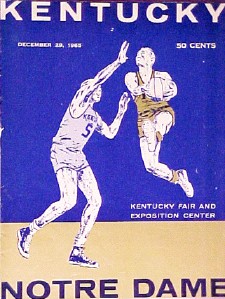 |
| 1965-66 Game Program |
As has been played out many times during his career after a crushing defeat, Rupp returned the next game with something to prove, and his retribution was harsh. After an uninspired first half, the Wildcats made a run which blew the game open and they defeated the Irish 103-69. The crowd, which otherwise probably would have made their way to the exits much earlier, stayed the course to see Jim LeMaster score a lay-up which put Kentucky over the century mark and return the onus of a century-mark shattering loss to Notre Dame.
All-American Pat Riley paced the Wildcats with 32 points while his All-American running mate, Louie Dampier added 26.
[Boxscore] - 1965-66
It's not a stretch to think that Rupp's idea of revenge went further than just one season. Kentucky followed up that win by adding another five to the streak. The losing apparently didn't affect Notre Dame coach Johnny Dee too badly as he did still have warm feelings toward the series and the festive atmosphere which surrounded it. Asked in 1967 about the annual event in Louisville, Dee enthused "This is the No. 1 game in the country -- absolutely the premium game of the year. It's the Rose Bowl of college basketball."
Despite being close at halftime, Kentucky was able to pull away in the end and extend their streak over the Irish for a number of years. The 1967 victory was one where UK Coach Adolph Rupp became the winningest college coach of all-time, passing his mentor in Kansas coach Forrest 'Phog' Allen. (At least according to Rupp's own counting which differed from the NCAA's official count as it included some International University tournament games in 1966. The current official NCAA mark is different than either as since that time, the games in 1966 were not counted but others were.)
On the Kentucky side, players such as Louie Dampier, Mike Casey and Dan Issel each took turns at playing the starring role. For the Irish, Bob Arnzen took up the fight but he was later joined by a young player who would set the series on its ear, if only for a short time. That player's name was Austin Carr.
[Boxscore] - 1966-67
[Boxscore] - 1967-68
[Boxscore] - 1968-69
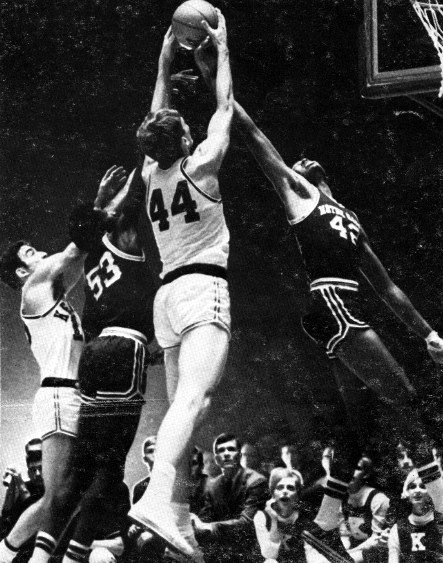 |
| Dan Issel (#44) fights Notre Dame's Bob Whitmore (#53) and Collis Jones (#42) for the rebound |
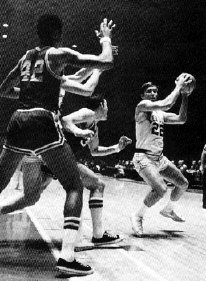 |
| Mike Pratt searches for an opening |
Notre Dame coach Johnny Dee saw the play differently.
"We got the ball right where we wanted it .. we got the shot we wanted, but we didn't get the free throw like we should have," Dee said, inferring that Catlett was fouled.
To make the injustice worse in Dee's eyes, the Irish were called for 26 personal fouls as compared to only 15 for Kentucky. "I just can't believe there is that much difference in the officiating at one end of the court than the other," said Dee.
Carr led all scorers with 43 points, but not far behind him was Kentucky's Mike Pratt, who tallied 42 points. Dan Issel added 35 points for the victors.
[Boxscore]- 1969-70
The next game occurred later the same season in the NCAA Tournament in the Mideast regional Semifinals in Columbus Ohio. Kentucky was sporting a #1 ranking and featured All-American senior Dan Issel. Rupp knew that this was probably his last chance to take the title away from a UCLA program (coached by John Wooden) which was well on its way to stealing the Baron's thunder over college basketball's landscape.
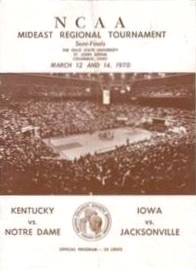 |
| 1970 NCAA Program |
The team heeded Rupp's words and Issel quickly caught fire, but it was not enough to put UK ahead, as the Wildcats trailed throughout the half and the #9 Irish extended the margin and led at halftime, 53-48.
Kentucky was in foul trouble and Rupp had to resort to a zone defense, a tactic he disdained in his early years but one which he found himself relying on at many crucial times late in his career. With just under 6 minutes remaining in the game, Notre Dame was leading 87-86 and Mike Pratt left the game on fouls when he was whistled for a foul against Notre Dame's Sid Catlett. Dan Issel converted two straight field goals to put the Wildcats back on top and largely owing to their 1-3-1 zone trap, the Wildcats were able to go on and outpoint their opponents for a ten point margin of victory.
Carr once again put on an amazing individual performance, with 52 points. Issel led Kentucky with 44 and 14 rebounds. Kentucky advanced but never got their shot at UCLA. The following game, Kentucky met Jacksonville and their twin towers of Artis Gilmore and Pembroke Burrows. Despite having Issel foul out with 10 minutes left in the game, the Wildcats fought valiantly only to fall 106-100.
[Boxscore]- 1970 NCAA Tournament
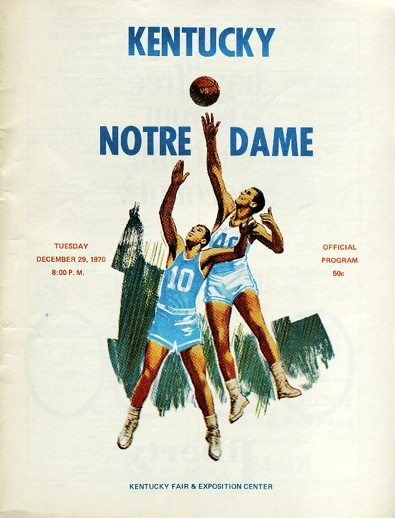 |
| December 1970 Program |
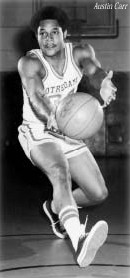 |
| Austin Carr |
Notre Dame ran out to a halftime lead of 53-39 and was able to expand that lead to 18 before Kentucky went on a 12-2 run of their own. Eventually the Wildcats would cut the lead to 6 but the Irish had the answer this time.
As with the previous game, Kentucky utilized a 1-3-1 zone defense, however the Irish were able to attack it. "Kentucky had one guy (forward Larry Steele) covering the whole baseline," said Dee. "And you just can't ask one guy to cover that much. We stayed with our game plan and attacked it the way we want to."
Collis Jones contributed 25 points and 14 rebounds to the Irish cause to go along with Carr's stellar outing. Mike Casey led Kentucky with 25 points.
According to Notre Dame Coach Johnny Dee, the Irish finally put everything together for this game. "We've lost some games we should have won to Kentucky the past few years," said Dee. "Our offense wasn't beating us, it was our defense. But last night Notre Dame put them both together."
After winning the first game he coached against UK as the head of the Irish, Dee was finally able to claim another victory against his old SEC rival Rupp (Dee had previously coached at Alabama). That would prove to be Dee's final game in the series as Dee would retire from coaching with a 116-80 record at Notre Dame. A year later, the Baron would follow his exit.
[Boxscore]- 1970-71
 |
| Johnny Dee and Adolph Rupp discuss the game ball while officials Charles Fouty and Ben Dunn look on |
Continue on to Part 2 "The Digger Phelps Era"
Please note that the following reference materials were consulted for the above. 1.) Lexington Herald 2.) Louisville Courier Journal 3.) Chicago Tribune 4.) Big Blue Machine by Russell Rice 5.) The Winning Tradition by Bert Nelli 6.) The Rupp Years by Tev Laudeman 7.) The Notre Dame Basketball Media Guide and 8.) the official Notre Dame Athletics website 9.) Coach by Ray Meyer among others. I'd also like to thank Dr. Jeffrey Neil Burch for locating many of the quotes found in this page.
![]()
Return to Kentucky Rivalries, Notre Dame Series Results, statistics, teams, opponents, players, coaches, opposing coaches, games or search this site.
Page written by Jon Scott. Please with any corrections or additional information.
Last Updated April 8, 2002